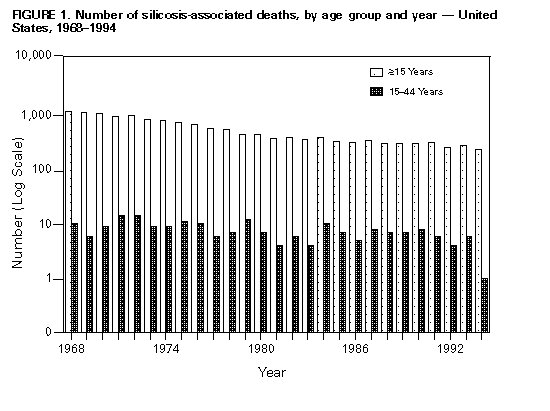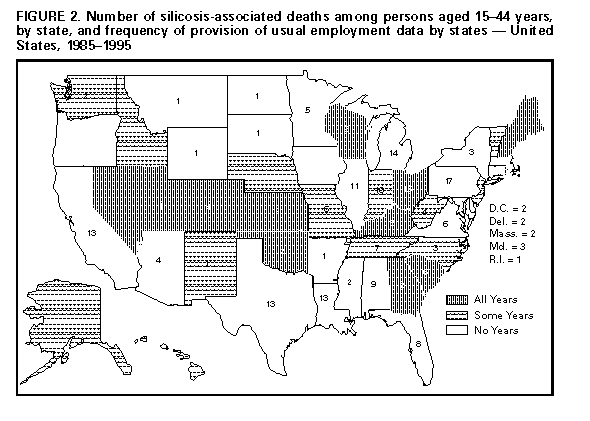 |
|
|
|
|
|
|
|
|
|
|
|
|
|
|
|
|
||||
| ||||||||||
|
|
|
|
Silicosis Deaths Among Young Adults -- United States, 1968-1994Silicosis is a potentially fatal and typically chronic fibrotic lung disease caused by occupational exposure to respirable crystalline silica dust (1). In the United States, most silicosis-associated deaths occur among persons aged greater than or equal to 65 years (2), often following many years of silica dust exposure. However, the continuing occurrence of silicosis deaths in young adults reflects relatively recent overexposures, some of sufficient magnitude to cause severe disease and death after relatively short periods of exposure. This report describes deaths among two young adults with silicosis and underscores the risk for deaths from silicosis at relatively young ages. Case Reports Two sandblasters died from progressive massive fibrosis (PMF), an advanced form of silicosis, following intensive dust exposure during abrasive sandblasting of oil field pipes and tanks in western Texas (3). The first death occurred in a 36-year-old man who had worked as a sandblaster for 36 months from 1984 to 1988, when PMF was diagnosed. He died from respiratory failure in 1995, 11 years after his initial exposure. The second death occurred in a 30-year-old man who had worked as a sandblaster for 48 months during 1986-1990. He died from respiratory failure in 1996, 10 years after initial exposure. At diagnosis, each worker had radiographic evidence of severe silicosis; one underwent a lung biopsy that revealed silicotic nodules and fibrosis. Autopsies for both revealed grey and hard upper and middle lobes of the lungs, with multiple small nodules palpable in the lower lobes. Microscopic examination revealed widespread interstitial inflammation and fibrosis, and mineralogic analysis revealed extremely high silica particle content. Mortality Surveillance Trends Using CDC's National Center for Health Statistics (NCHS) multiple cause-of-death data files for all U.S. deaths from 1968 through 1994, presumptive silicosis deaths were identified using International Classification of Diseases (ICD) codes * listed as either an underlying or contributing cause of death among persons aged greater than or equal to 15 years. Descriptive analyses were conducted using three age groups (15-44 years, 45-64 years, and greater than or equal to 65 years). Usual industry and occupation, coded in accordance with Bureau of Census industry and occupation codes, were examined in the NCHS data files. During 1968-1994, a total of 14,824 silicosis-associated deaths were recorded; 11,250 (75.9%) occurred among persons aged greater than or equal to 65 years, 3367 (22.7%) among persons aged 45-64 years, and 207 (1.4%) among persons aged 15-44 years. Overall, silicosis deaths declined substantially from 1157 in 1968 to less than 400 annually after 1980 (Figure_1). Among young persons (i.e., aged 15-44 years), deaths from silicosis declined less during 1968-1994 (Figure_1). Young silicosis decedents resided in 38 states and the District of Columbia (Figure_2); 17 (8.2%) were aged 15-24 years; 40 (19.3%), aged 25-34 years; and 150 (72.5%), aged 35-44 years. Among young silicosis decedents, 57.0% were white, and 90.8% were male. Among silicosis decedents aged greater than or equal to 65 years, 90.0% were white, and 98.1% were male. The proportion of decedents of races other than white generally increased during 1968-1994 in both the 45-64 and greater than or equal to 65 age groups, but remained relatively stable among young decedents. In all three age groups, the proportion of female decedents generally increased. Of the nine silicosis deaths that occurred among young women during 1985-1994, six were of races other than white. Reporting to NCHS of the "usual" industry and occupation of decedents began in 1985, with varying numbers of states (range: 16-22 states) providing this information in that and subsequent years (Figure_2). Of the 59 young silicosis decedents during 1985-1994, a total of 25 (42.4%) died in a year for which their state of residence provided decedents' employment information to NCHS. Construction and manufacturing were coded most frequently as the usual industry (28.0% each); no deaths were attributed to mining. In comparison, among 897 silicosis decedents aged greater than or equal to 65 years, manufacturing accounted for 46.2% , mining for 21.1%, and construction for 9.5% of deaths. Usual occupations for the 25 young silicosis decedents included operators of various machines used to crush, grind, mix, and blend materials (six {24.0%}); painters/paint spray operators (five {20.0%}); construction trades (four {16.0%}); and laborers, except construction (four {16.0%}). Reported by: Div of Respiratory Disease Studies, National Institute for Occupational Safety and Health; and an EIS officer, CDC. Editorial NoteEditorial Note: Primary prevention of silicosis through exposure control is important because no effective medical treatment exists for this disease, which continues to progress even after a worker is removed from further exposure (4). Despite the existence of legally enforceable limits on worker exposure to respirable crystalline silica dust, overexposures of sufficient magnitude to cause premature deaths continue to occur in the United States. Silicosis latency and rate of progression correlate with intensity of exposure (5); extremely high exposures are associated with much shorter latency and more rapid disease progression. Consequently, silicosis-associated deaths in young persons generally result from more recent and intense exposure to silica dust. The sex, racial, and employment differences between young and older silicosis decedents presented in this report may reflect changes in both workforce demographics and industrial activity over recent decades, especially given the increasing proportion of females among young silicosis decedents. The high, but temporally constant, proportion of minorities among young silicosis decedents may reflect the generally higher levels of dust to which minority workers have been exposed (6,7). For example, in the foundry industry, higher levels of silica dust exposure accounted for apparently higher risk for silicosis among black workers than among white workers (7). Extreme overexposures to respirable silica have been documented during sandblasting (5) and in the construction industry (8). Abrasive blasting with silica sand, often used to prepare surfaces for painting, has been associated with exposures up to 200 times the CDC's National Institute for Occupational Safety and Health (NIOSH)-recommended exposure limit for respirable crystalline silica dust (0.05 mg/m3) (5). NIOSH has recommended that silica sand be prohibited as an abrasive blasting agent (5). The findings in this report are subject to several limitations. The ICD code used to identify presumptive silicosis is not entirely specific for silicosis, and cause-of-death coding errors can occur. However, a review of a sample of death certificates of 10 young decedents in whom silicosis was presumptively diagnosed found that only two were not attributable to silicosis. In addition, many states do not provide decedents' employment data to NCHS, and the Census employment codes lack substantial detail. Even when recorded accurately and coded appropriately, silicosis decedents' usual employment does not always represent employment relevant to silica exposure. Finally, the NCHS data lack personal identifiers necessary for follow-back to confirm silicosis as cause of death, to ascertain details about occupational exposure to silica dust, and to investigate specific workplaces for potential ongoing hazardous exposure. The Sentinel Event Notification System for Occupational Risks (SENSOR) program ** and a preexisting surveillance program in New Jersey have demonstrated that identifying silicosis deaths from state mortality data files is one of several useful case-ascertainment methods for state-based silicosis surveillance and related preventive intervention (9). Although implementation of all silicosis case ascertainment methods and case follow-up activities field-tested through SENSOR may be optimal, state health departments often do not have sufficient resources for a comprehensive approach. In 1997, the Council of State and Territorial Epidemiologists adopted a resolution recommending that silicosis be made a reportable condition. Regardless of reporting requirement status, state health departments can initiate active efforts in silicosis prevention by identifying silicosis deaths through annual review of state mortality data and giving priority to investigation of circumstances surrounding those that occur at younger ages. Additional information about silicosis prevention activities and technical assistance for worksite investigations and other follow-back activities are available from NIOSH, telephone (304) 285-6115. References
* The Eighth Revision (ICD-8) codes 010 and 515.0 were used for 1968-1978, and the Ninth Revision (ICD-9) code 502 was used for 1979-1994. ** The SENSOR program, involving cooperative agreements between NIOSH and state health departments, is designed to develop and field test surveillance and intervention strategies for selected occupational conditions. Figure_1  Return to top. Figure_2  Return to top. Disclaimer All MMWR HTML versions of articles are electronic conversions from ASCII text into HTML. This conversion may have resulted in character translation or format errors in the HTML version. Users should not rely on this HTML document, but are referred to the electronic PDF version and/or the original MMWR paper copy for the official text, figures, and tables. An original paper copy of this issue can be obtained from the Superintendent of Documents, U.S. Government Printing Office (GPO), Washington, DC 20402-9371; telephone: (202) 512-1800. Contact GPO for current prices. **Questions or messages regarding errors in formatting should be addressed to mmwrq@cdc.gov.Page converted: 10/05/98 |
|||||||||
This page last reviewed 5/2/01
|